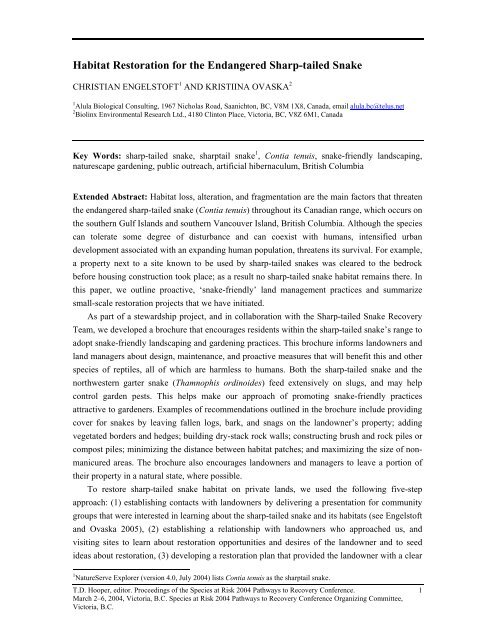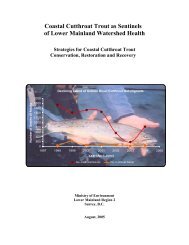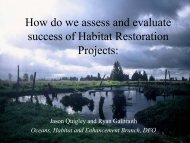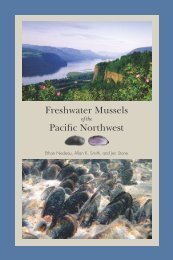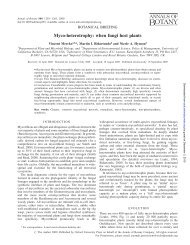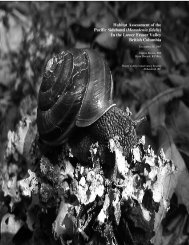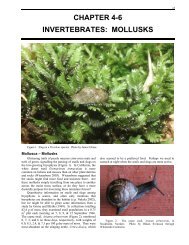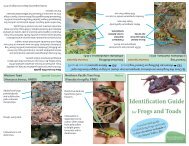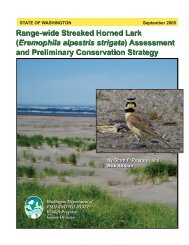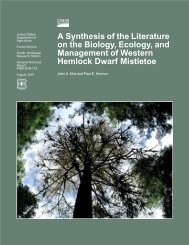Habitat Restoration for the Endangered Sharp-tailed Snake
Habitat Restoration for the Endangered Sharp-tailed Snake
Habitat Restoration for the Endangered Sharp-tailed Snake
You also want an ePaper? Increase the reach of your titles
YUMPU automatically turns print PDFs into web optimized ePapers that Google loves.
<strong>Habitat</strong> <strong>Restoration</strong> <strong>for</strong> <strong>the</strong> <strong>Endangered</strong> <strong>Sharp</strong>-<strong>tailed</strong> <strong>Snake</strong>CHRISTIAN ENGELSTOFT 1 AND KRISTIINA OVASKA 21 Alula Biological Consulting, 1967 Nicholas Road, Saanichton, BC, V8M 1X8, Canada, email alula.bc@telus.net2 Biolinx Environmental Research Ltd., 4180 Clinton Place, Victoria, BC, V8Z 6M1, CanadaKey Words: sharp-<strong>tailed</strong> snake, sharptail snake 1 , Contia tenuis, snake-friendly landscaping,naturescape gardening, public outreach, artificial hibernaculum, British ColumbiaExtended Abstract: <strong>Habitat</strong> loss, alteration, and fragmentation are <strong>the</strong> main factors that threaten<strong>the</strong> endangered sharp-<strong>tailed</strong> snake (Contia tenuis) throughout its Canadian range, which occurs on<strong>the</strong> sou<strong>the</strong>rn Gulf Islands and sou<strong>the</strong>rn Vancouver Island, British Columbia. Although <strong>the</strong> speciescan tolerate some degree of disturbance and can coexist with humans, intensified urbandevelopment associated with an expanding human population, threatens its survival. For example,a property next to a site known to be used by sharp-<strong>tailed</strong> snakes was cleared to <strong>the</strong> bedrockbe<strong>for</strong>e housing construction took place; as a result no sharp-<strong>tailed</strong> snake habitat remains <strong>the</strong>re. Inthis paper, we outline proactive, ‘snake-friendly’ land management practices and summarizesmall-scale restoration projects that we have initiated.As part of a stewardship project, and in collaboration with <strong>the</strong> <strong>Sharp</strong>-<strong>tailed</strong> <strong>Snake</strong> RecoveryTeam, we developed a brochure that encourages residents within <strong>the</strong> sharp-<strong>tailed</strong> snake’s range toadopt snake-friendly landscaping and gardening practices. This brochure in<strong>for</strong>ms landowners andland managers about design, maintenance, and proactive measures that will benefit this and o<strong>the</strong>rspecies of reptiles, all of which are harmless to humans. Both <strong>the</strong> sharp-<strong>tailed</strong> snake and <strong>the</strong>northwestern garter snake (Thamnophis ordinoides) feed extensively on slugs, and may helpcontrol garden pests. This helps make our approach of promoting snake-friendly practicesattractive to gardeners. Examples of recommendations outlined in <strong>the</strong> brochure include providingcover <strong>for</strong> snakes by leaving fallen logs, bark, and snags on <strong>the</strong> landowner’s property; addingvegetated borders and hedges; building dry-stack rock walls; constructing brush and rock piles orcompost piles; minimizing <strong>the</strong> distance between habitat patches; and maximizing <strong>the</strong> size of nonmanicuredareas. The brochure also encourages landowners and managers to leave a portion of<strong>the</strong>ir property in a natural state, where possible.To restore sharp-<strong>tailed</strong> snake habitat on private lands, we used <strong>the</strong> following five-stepapproach: (1) establishing contacts with landowners by delivering a presentation <strong>for</strong> communitygroups that were interested in learning about <strong>the</strong> sharp-<strong>tailed</strong> snake and its habitats (see Engelstoftand Ovaska 2005), (2) establishing a relationship with landowners who approached us, andvisiting sites to learn about restoration opportunities and desires of <strong>the</strong> landowner and to seedideas about restoration, (3) developing a restoration plan that provided <strong>the</strong> landowner with a clear1 NatureServe Explorer (version 4.0, July 2004) lists Contia tenuis as <strong>the</strong> sharptail snake.T.D. Hooper, editor. Proceedings of <strong>the</strong> Species at Risk 2004 Pathways to Recovery Conference. 1March 2–6, 2004, Victoria, B.C. Species at Risk 2004 Pathways to Recovery Conference Organizing Committee,Victoria, B.C.
<strong>Habitat</strong> <strong>Restoration</strong> <strong>for</strong> <strong>the</strong> <strong>Sharp</strong>-<strong>tailed</strong> <strong>Snake</strong>Engelstoft and Ovaskaunderstanding of what <strong>the</strong> project en<strong>tailed</strong>. The action on <strong>the</strong> ground started only after <strong>the</strong>landowner signed off on <strong>the</strong> plan. This approach was crucial to ensuring that everything wentsmoothly during construction, and that any misunderstandings were avoided, (4) buildingstructures in accordance with <strong>the</strong> plan with <strong>the</strong> help of volunteers who were recruited fromworkshop participants and local conservation groups, and (5) monitoring <strong>the</strong> snakes’ use of <strong>the</strong>restored habitat.In 2003, we conducted three sharp-<strong>tailed</strong> snake habitat restoration projects on privateproperties. A fourth project was undertaken by Laura Matthias in 2002 as a student project <strong>for</strong> adiploma in <strong>Restoration</strong> Biology at <strong>the</strong> University of Victoria. That project, conducted in an areapreviously used by <strong>the</strong> sharp-<strong>tailed</strong> snake, consisted of creating a multi-layered structure in alarge hole left by a fallen tree (all material above <strong>the</strong> bedrock had been removed when <strong>the</strong> treefell). In <strong>the</strong> three projects undertaken in 2003, we attempted to incorporate different experimentalstructures (hibernacula and egg-laying structures) into retaining walls that we built. The artificialhibernacula consisted of a frost-free and moist environment in a core area that was covered withan insulating layer. Because little is known about <strong>the</strong> sharp-<strong>tailed</strong> snake’s requirements <strong>for</strong>hibernation sites, we incorporated rocks of different coarseness (sand, gravel, cobble, andboulder) and wood into <strong>the</strong> structure, and carefully positioned larger rocks to provide a moisturegradient. These different materials and rock sizes were used to provide a variety of microhabitatswithin <strong>the</strong> structure. To investigate whe<strong>the</strong>r <strong>the</strong> snakes were using <strong>the</strong> structures, we incorporatedseveral 3.8 cm pipes into <strong>the</strong> structures to provide camera access to <strong>the</strong> core of <strong>the</strong> hibernacula.The insulating layers over <strong>the</strong> hibernacula were created by placing up to 1 m of soil on top of <strong>the</strong>structures. Two of <strong>the</strong> hibernacula were built on a slope and were retained by a dry-stack wall offlat rocks that offered many crevices <strong>for</strong> <strong>the</strong> snakes to access <strong>the</strong> core. The o<strong>the</strong>r hibernaculumwas built behind a retaining wall that bordered <strong>the</strong> end of a driveway.The sharp-<strong>tailed</strong> snake is <strong>the</strong> only egg-laying reptile in southwestern British Columbia, butlittle is know about its requirements <strong>for</strong> egg-laying sites. At one location, we constructed anartificial egg-laying site within a retaining wall on a south-facing, exposed slope. Gravel and soilmade up <strong>the</strong> core of <strong>the</strong> egg-laying site, which was covered by 15–30 cm of loose soil. Coverobjects (flat rocks and pieces of roofing asphalt <strong>for</strong> <strong>the</strong> snakes to hide under) were placed on <strong>the</strong>structure to monitor <strong>the</strong> species’ presence in <strong>the</strong> area, but we had no access to <strong>the</strong> interior of <strong>the</strong>structure where eggs would be deposited. In ano<strong>the</strong>r ongoing project, we incorporated structuresinto an egg-laying site which will allow us to monitor <strong>the</strong> use of <strong>the</strong> interior by snakes. We didthis by constructing a pit behind <strong>the</strong> top of a retaining wall, and placing a stack of six open traysmade of 1.2 cm mesh hardware cloth in <strong>the</strong> pit. The plan is to fill <strong>the</strong>se trays with differentmaterials such as compost, sphagnum, or decomposing wood to experiment with substratepreferences of <strong>the</strong> snakes. The trays can <strong>the</strong>n be lifted <strong>for</strong> inspection.In 2004, we will begin monitoring <strong>the</strong> use of <strong>the</strong> restored structures by sharp-<strong>tailed</strong> snakes.We encourage landowners to become involved in this activity to maintain <strong>the</strong>ir continued interestin <strong>the</strong> project.Proc. Species at Risk 2004 Pathways to Recovery Conference. 2March 2–6, 2004, Victoria, B.C.
<strong>Habitat</strong> <strong>Restoration</strong> <strong>for</strong> <strong>the</strong> <strong>Sharp</strong>-<strong>tailed</strong> <strong>Snake</strong>Engelstoft and OvaskaReferencesEngelstoft, C., and K. Ovaska. 2005. <strong>Sharp</strong>-<strong>tailed</strong> snake stewardship initiatives. In T.D. Hooper,editor. Proceedings of <strong>the</strong> Species at Risk 2004 Pathways to Recovery Conference.March 2–6, 2004, Victoria, British Columbia. Species at Risk 2004 Pathways toRecovery Conference Organizing Committee, Victoria, British Columbia.Proc. Species at Risk 2004 Pathways to Recovery Conference. 3March 2–6, 2004, Victoria, B.C.


